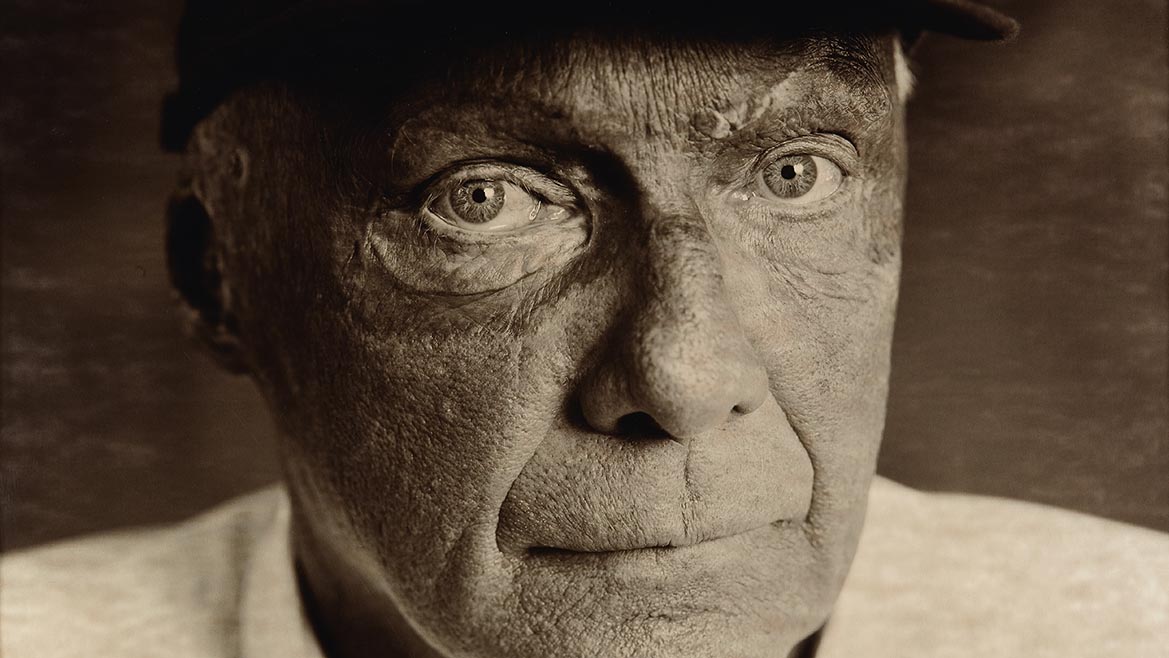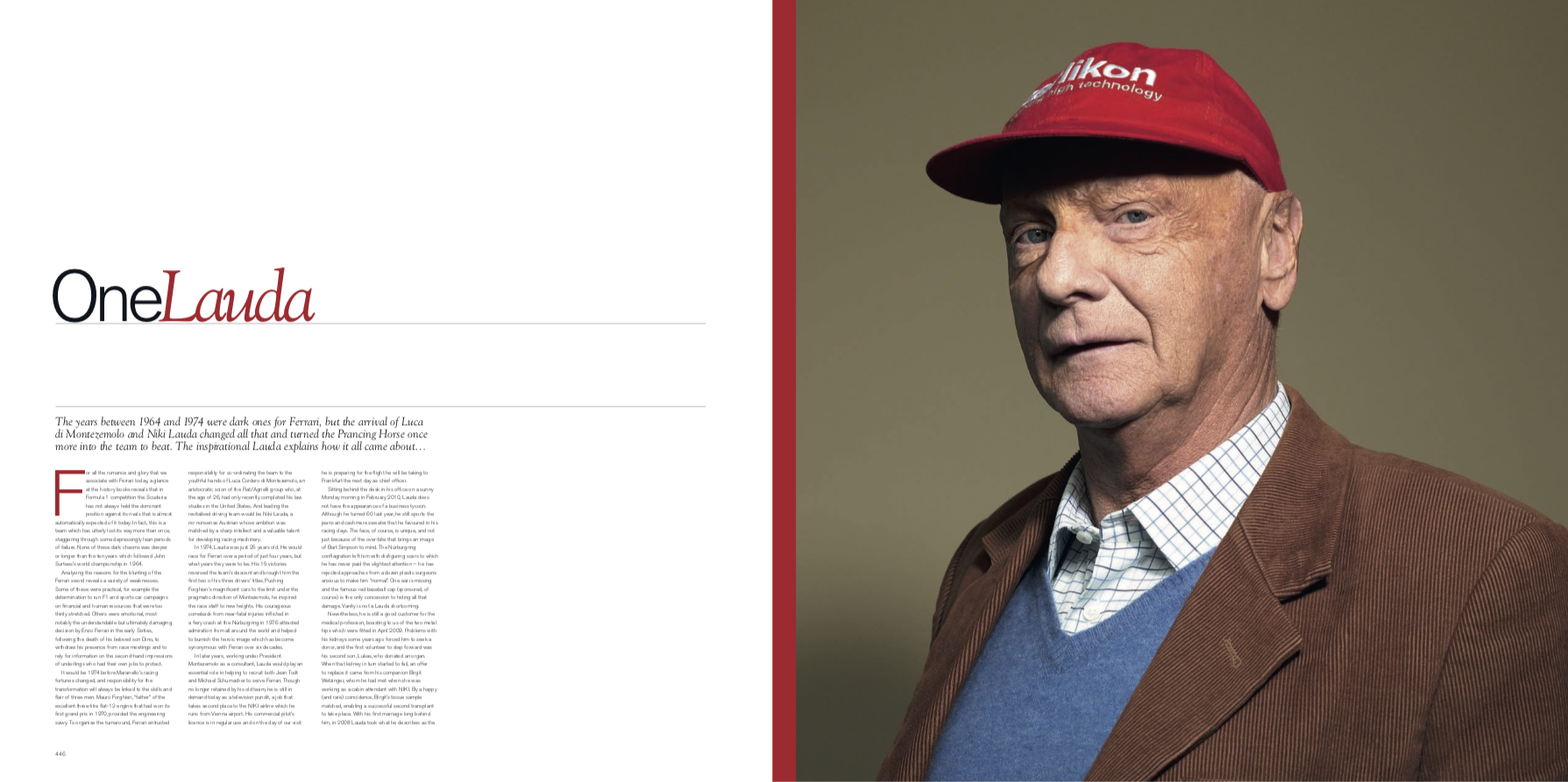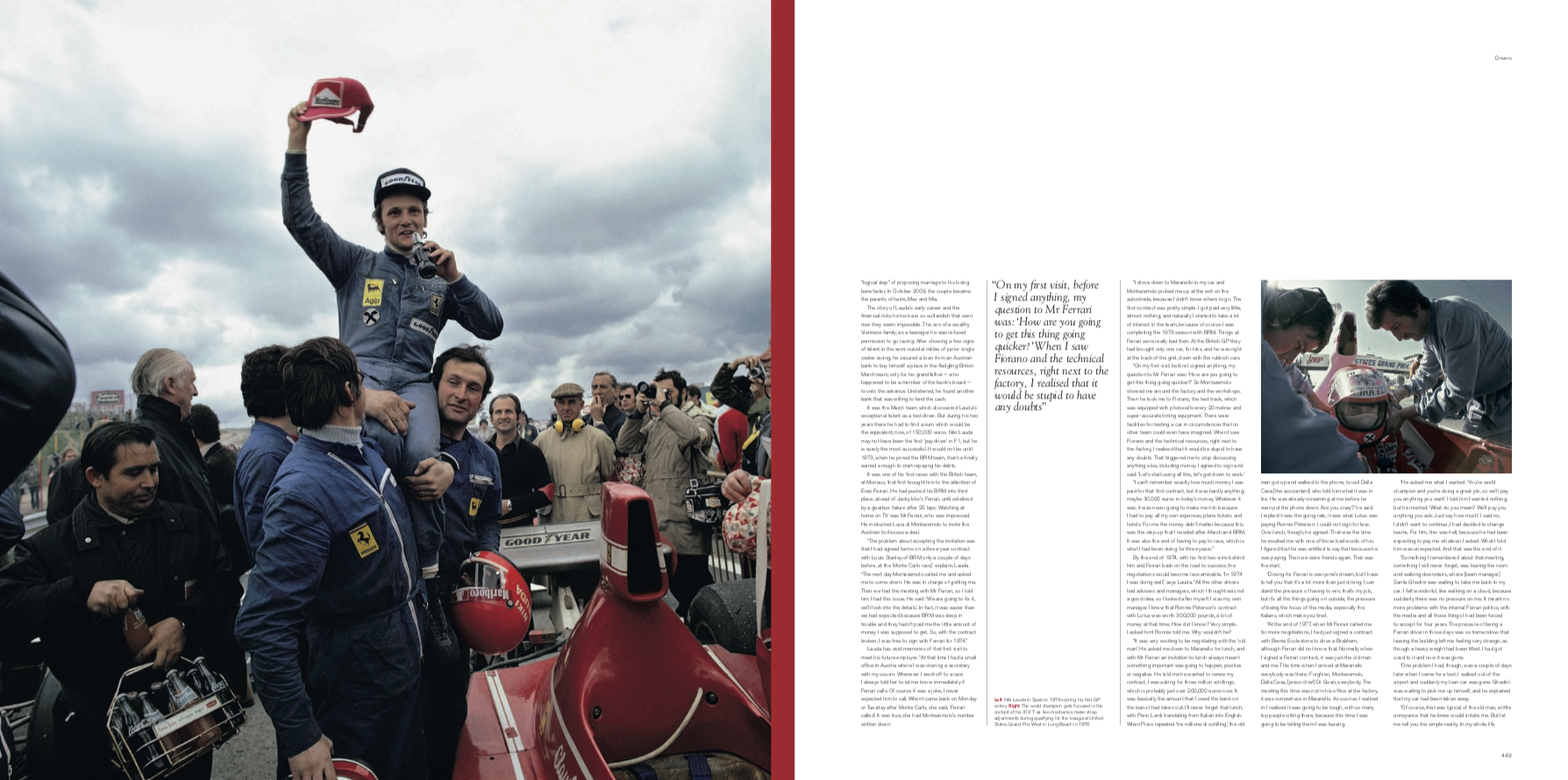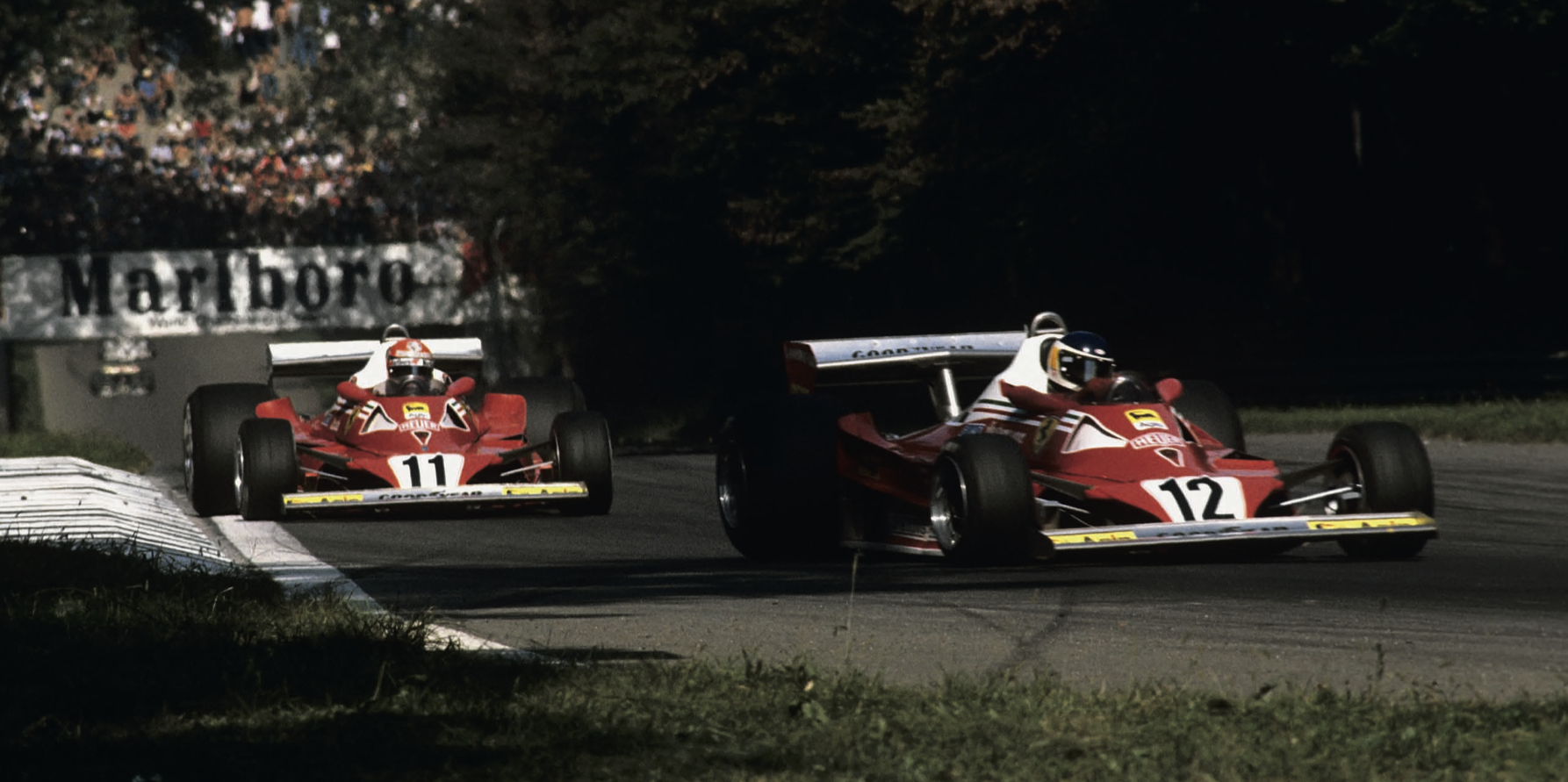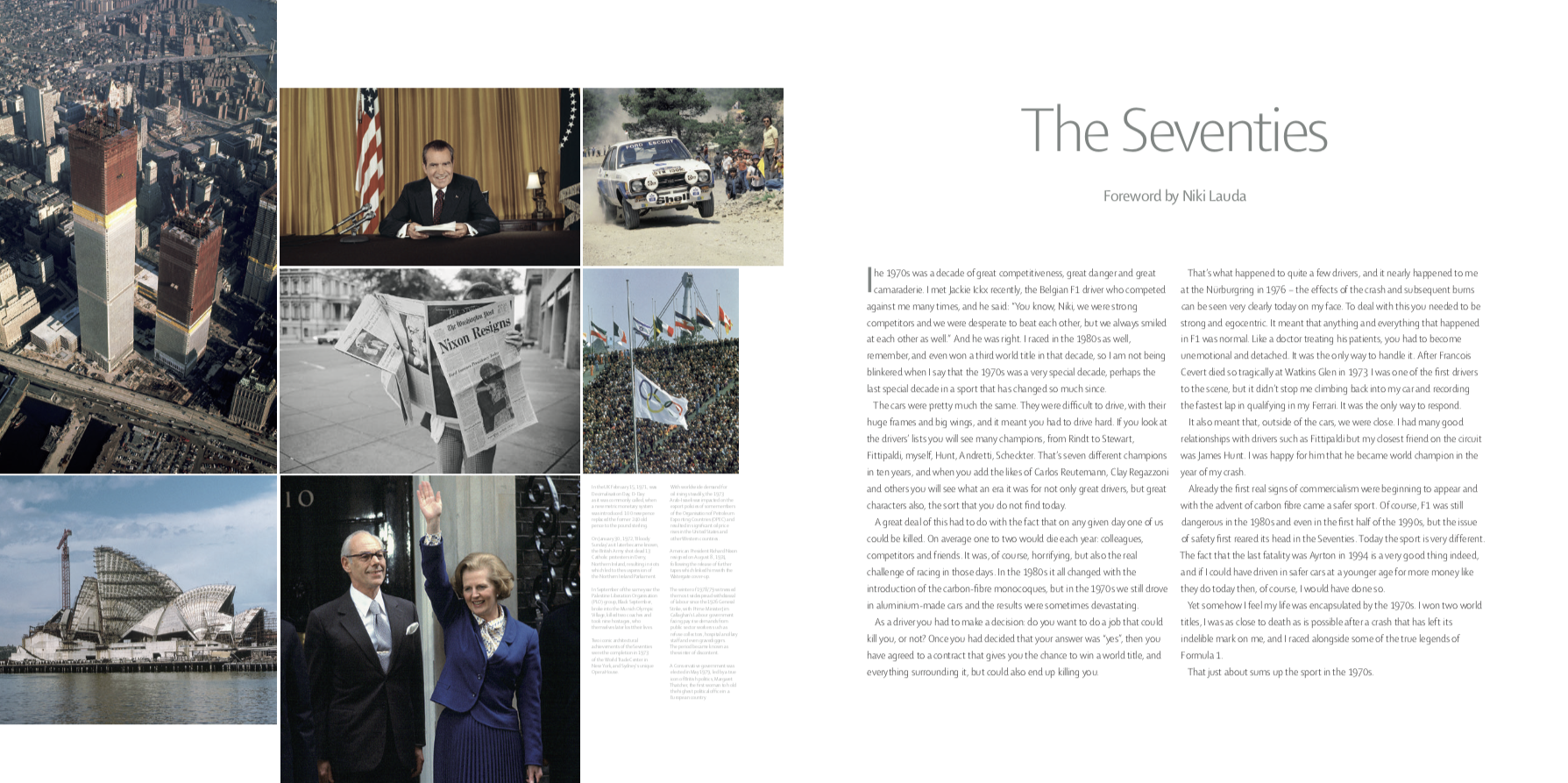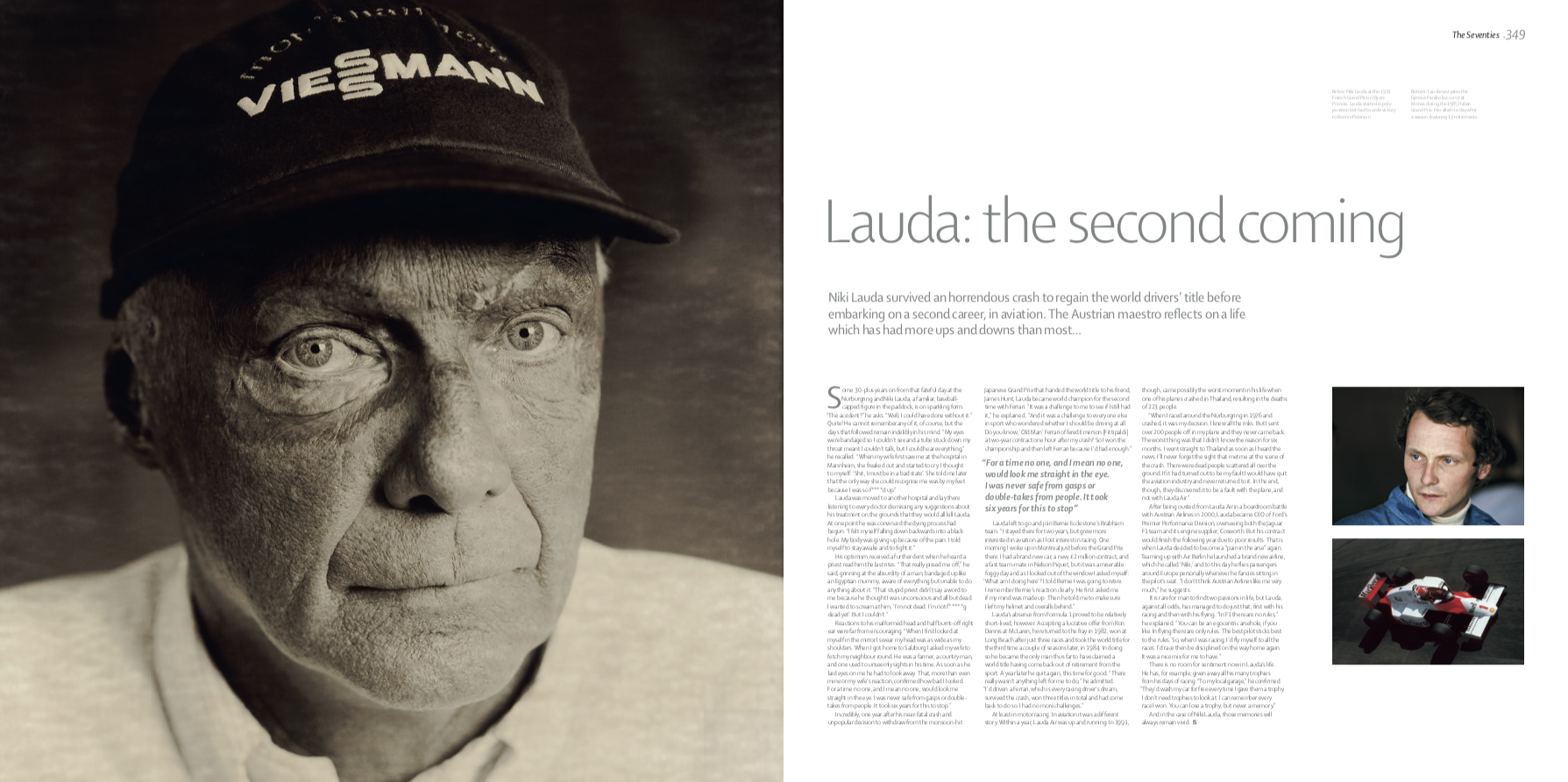A special interview taken from The Official Ferrari Opus
For all the romance and glory that we associate with Ferrari today, a glance at the history books reveals that in Formula 1 competition the Scuderia has not always held the dominant position against its rivals that is almost automatically expected of it today. In fact, this is a team which has utterly lost its way more than once, staggering through some depressingly lean periods of failure. None of these dark chasms was deeper or longer than the ten years which followed John Surtees’s world championship in 1964.
Analysing the reasons for the blunting of the Ferrari sword reveals a variety of weaknesses. Some of these were practical, for example the determination to run F1 and sports car campaigns on fi nancial and human resources that were too thinly stretched. Others were emotional, most notably the understandable but ultimately damaging decision by Enzo Ferrari in the early Sixties, following the death of his beloved son Dino, to withdraw his presence from race meetings and to rely for information on the second-hand impressions of underlings who had their own jobs to protect.
It would be 1974 before Maranello’s racing fortunes changed, and responsibility for the transformation will always be linked to the skills and fl air of three men. Mauro Forghieri, “father” of the excellent three-litre fl at-12 engine that had won its fi rst grand prix in 1970, provided the engineering savvy. To organise the turnaround, Ferrari entrusted responsibility for co-ordinating the team to the youthful hands of Luca Cordero di Montezemolo, an aristocratic scion of the Fiat/Agnelli group who, at the age of 26, had only recently completed his law studies in the United States. And leading the revitalised driving team would be Niki Lauda, a no-nonsense Austrian whose ambition was matched by a sharp intellect and a valuable talent for developing racing machinery.
In 1974, Lauda was just 25 years old. He would race for Ferrari over a period of just four years, but what years they were to be. His 15 victories reversed the team’s descent and brought him the first two of his three drivers’ titles. Pushing Forghieri’s magnifi cent cars to the limit under the pragmatic direction of Montezemolo, he inspired the race staff to new heights. His courageous comeback from near-fatal injuries inflicted in a fiery crash at the Nürburgring in 1976 attracted admiration from all around the world and helped to burnish the heroic image which has become synonymous with Ferrari over six decades.
In later years, working under President Montezemolo as a consultant, Lauda would play an essential role in helping to recruit both Jean Todt and Michael Schumacher to serve Ferrari. Though no longer retained by his old team, he is still in demand today as a television pundit, a job that takes second place to the NIKI airline which he runs from Vienna airport. His commercial pilot’s licence is in regular use and on the day of our visit he is preparing for the fl ight he will be taking to Frankfurt the next day as chief officer.
Sitting behind the desk in his offi ce on a sunny Monday morning in February 2010, Lauda does not have the appearance of a business tycoon. Although he turned 60 last year, he still sports the jeans and cashmere sweater that he favoured in his racing days. The face, of course, is unique, and not just because of the over-bite that brings an image of Bart Simpson to mind. The Nürburgring conflagration left him with disfiguring scars to which he has never paid the slightest attention — he has rejected approaches from a dozen plastic surgeons anxious to make him “normal”. One ear is missing and the famous red baseball cap (sponsored, of course) is the only concession to hiding all that damage. Vanity is not a Lauda shortcoming.
Nevertheless, he is still a good customer for the medical profession, boasting to us of the two metal hips which were fitted in April 2009. Problems with his kidneys some years ago forced him to seek a donor, and the first volunteer to step forward was his second son, Lukas, who donated an organ. When that kidney in turn started to fail, an offer to replace it came from his companion Birgit Wetzinger, whom he had met when she was working as a cabin attendant with NIKI. By a happy (and rare) coincidence, Birgit’s tissue sample matched, enabling a successful second transplant to take place. With his first marriage long behind him, in 2008 Lauda took what he describes as the I never met anyone who had the charismatic personality of Enzo Ferrari. There was never anyone quite like him or anyone who acted like he did. When he loved you — and, luckily for me, he loved me for most of the time — he had a big heart. There was a bad side to him, certainly, but as long as he loved you, it was impossible to see the bad side. An extraordinary personality.
“It is easy now to look back and see what I missed when I left Ferrari. When Ecclestone came along with the Alfa engine and Parmalat money, it seemed wonderful. It meant less stress and I would get three times as much as Ferrari was paying me. It was nice to be able to tell Ferrari to keep his money and fi nd someone else to drive. Of course, in the end it was a mistake: if I had stayed with Ferrari I would have been much more successful.
“I am glad to say that our relationship ended up on friendly terms. Six years after I had left Ferrari, he was at Imola, on one of his very rare visits to a racing circuit, when I was testing with McLaren. I spotted him as he was being driven out of the back paddock, so I stood in front of his car to make the driver stop. He got out and hugged me, like a son, asking questions about my family. He was charming, 84 years old and getting close to the end of his life.”
It is generally believed Mr Ferrari’s true affection extended to only one driver after Lauda’s departure. That man was Gilles Villeneuve, the Canadian whose devil-may-care driving thrilled millions of fans but would ultimately bring his life to an early end in a practice accident at Zolder in 1982.
“Villeneuve was exactly the kind of driver that Ferrari loved,” Lauda remembers. “He was Canadian but he was also the sort of Latin-style driver that Ferrari appreciated. The old man always spoke positively about him. I also had a very good relationship with Villeneuve, at least away from the circuit. One incident I remember was at Zolder
— actually on the weekend when he was killed — when I was in the hotel after dark and suddenly I heard the sound of a helicopter, flying in at ten o’clock at night. When I looked out of the window, there was this helicopter with a light shining from it, as the pilot was trying to find a place to land.
“Of course, I knew who it was and the next morning I went to see him. ‘There is something wrong in the head,’ I said. ‘You must know you’re not allowed to fl y at night.’ ‘I know, I know,’ he said, ‘but I didn’t leave Nice until too late, and I had to refuel…’ It still wasn’t very clever.
“Then on Friday we went out for fi rst practice, and I followed him out on the track. I was going slow, to see how my car was handling, and on the second lap he spun off on the fastest corner on the circuit. After the session I walked up to him again. ‘Why are you so stupid?’ I said. ‘Tell me. We drive slow and wait until the other drivers have cleaned the circuit, then we can concentrate on setting a quick time.’ ‘Niki,’ he replied, ‘I can’t do it different. Whenever I get in a racing car, I can only drive one way, and that’s balls out, I have to do it like that.’ As I said, that was the weekend he was killed…
“I remember another race, a non-championship event at Imola in 1979. I was in the Brabham-Alfa, with Villeneuve behind me, fighting Pironi. I was braking for the corner at the end when he touched my rear wheel and broke off the nose of his car. He couldn’t do anything then; he went into the pits and I won the race. ‘You should have waited one more lap because you would have passed me anyway,’ I told him later. But that was the way Villeneuve was, and it is why he will always be remembered.”
Lauda’s memories of Ayrton Senna are perhaps less cordial. The two men raced against each other for two seasons, in 1984 and 1985, and later the Brazilian would take over the McLaren place that Lauda had vacated when he finally retired from F1 at the end of 1985.
“In that final year I remember in Monte Carlo, after Senna had taken provisional pole position and I was doing my quick lap. He was on the racing line in front of me, not moving. Any chance of pole position for me was gone. Afterwards I went up to him and said: ‘Why are you blocking?’ He replied, ‘Why should I not block?’ I told him we are both in the same boat, trying to get pole position. Why the stupid attitude? ‘Because that’s the way I am,’ he said and walked away.
‘So the next day, all through practice, I was waiting for him. All practice. When at last his car came behind me, I stopped. To zero. Didn’t even move my car. He nearly ran into the back of me. After this he came up to me, screaming like you can’t believe. ‘Did you get the message?’ I asked him. ‘You screwed me up. Is it clever or not?’ In the end he came back and said, ‘Okay, peace…’ Maybe that was his way of showing a little respect.”
Lauda recognises that without Luca di Montezemolo, Ferrari would never have returned to its winning ways. “I knew before I met him that Luca was part of the Agnelli group. Gianni Agnelli supported him because he was such a bright guy. In Italy, when you have studied abroad as Luca had done, it means you have an advantage in life. He was also very demanding, highly intelligent. The good part was that we were about the same age, and we had a very constructive discussion about how the team should be and what were the important things to change. With support from my team-mate Clay Regazzoni, who had recommended me to Luca, I was the master there. Luca and I had a very good, close personal relationship, I would say very much like Schumacher with Todt in the great days of their collaboration, or now with Ross Brawn.
“So we pushed each other into the best position to move forward and the only thing I had to do to stay there was to keep ahead of Regazzoni. It worked very well. The only time when I got really upset with Luca was at Monte Carlo the year [1974] when I was on pole position with him second fastest. At that time the pole position guy could choose which side of the grid he wanted to start from, and when I came down from the hotel on Sunday morning I discovered I was on the wrong side, on the left. ‘What happened here?’ I asked. ‘Oh, Montezemolo changed it,’ I was told. ‘What? Are you nuts?’ I said to Luca. ‘Why did you change it?’ ‘Oh, Clay told me to do it,’ he replied. ‘Ronnie Peterson’s Lotus is in third place behind you, he is the strongest opposition to us and it’s better for the team like this.’ ‘You’re stupid,’ I said. ‘Can’t you see that with Clay on the inside he’s going to get into the first corner in front of me, even though he was only second fastest in qualifying?’
“Anyway, after the argument, Clay was able to get into the lead, just as I predicted. But then — and I will never forget this, because I was pushing him like crazy – Clay spun. So the race was over and I was leading. But then my generator broke, so we got nothing from the race. Luca wasn’t happy, of course. ‘Clay only spun because you were right behind him, why did you push him so hard?’ he asked. ‘Because you put him in the wrong position on the grid!’ I replied. That was the only real argument I ever had with him.
“There was another incident in Madrid in 1974, my fi rst grand prix with Ferrari, which shows how passionate — and how innocent — Montezemolo was at that time. I was leading the race and he rushed off to see the race director, to put out the chequered fl ag and stop the race early! I actually saw the two of them arguing as I crossed the line with three laps to go before the end of the race. Completely crazy!
“Recently I saw another incident like that, on TV, at Monte Carlo, when I was leading, and again Montezemolo was in front of the pits with the race director, demanding to get the race stopped early. As I went past he stormed forward and someone had to pull him back! He always was a highly emotional guy. Still is.
“We stayed in touch, though lately we only talk occasionally on the phone. I spoke to him recently. Now he’s got Fernando Alonso as his star driver and he’s very happy about that. He’s perhaps not quite so happy that Michael Schumacher has come back with Mercedes. Jean Todt and the stupid contract he gave Michael; it was supposed to be a marketing tool. Five million dollars a year! Michael told us he would retire and work for Ferrari. We paid all that money and now he’s driving for Mercedes!”
It was Lauda who had urged Montezemolo to employ both Todt and Schumacher. “When Montezemolo took overall control at Ferrari, [in 1991], he offered me a job. I was running my airline at the time and was too busy, so he asked me to be a consultant. The first thing I did was to arrange for Ferrari to take on Todt. At the time Ferrari wanted to use an Italian, but I recommended someone international. So I got in touch with Todt and interviewed him in Salzburg, then introduced him to Montezemolo and together we negotiated the contract which brought him to Maranello.
“In 1995, I also made the first contact with Schumacher, who was with Benetton. I spoke to his manager [Willi Weber] in Brazil. I called Luca from Brazil and told him: ‘Schumacher is the guy we need, but we have to start now, before any of the other teams start talking to him.’ Luca gave me permission to go ahead, so I went to see Weber while we were still in Brazil and recommended that Michael should drive for Ferrari. Weber insisted the Ferrari car was no good and that Michael would do better by staying at Benetton. It was a typically short-sighted attitude. But a week later he called me. ‘We might be interested,’ he said. Clever. It only takes him a week to think the same way as me…
“I started negotiating. Everything went backwards and forwards for about a month, and then I had to ring Luca on another subject. ‘Todt is negotiating with Weber and Schumacher in Monte Carlo,’ he said. ‘Where am I in the deal?’ I asked. ‘I did all the original negotiations, including how much money should be offered.’ Luca said it would be better for Todt to do the deal, but he ended up paying half a million more than he should have done, because he never checked with me on the figures…
“Then Todt decided that they didn’t need me anymore, and put so much pressure on Luca that they didn’t renew my contract. That was it. But ofcourse they were very successful together. Whatever happened between Todt and me, I would never deny that he was the right choice to lead Ferrari. With Schumacher driving he did a great job and the results were unbelievable.”
A special foreword taken from The Official Formula 1 Opus
The 1970s was a decade of great competitiveness, great danger and great camaraderie. I met Jackie Ickx recently, the Belgian F1 driver who competed against me many times, and he said: “You know, Niki, we were strong competitors and we were desperate to beat each other, but we always smiled at each other as well.” And he was right. I raced in the 1980s as well, remember, and even won a third world title in that decade, so I am not being blinkered when I say that the 1970s was a very special decade, perhaps the last special decade in a sport that has changed so much since.
The cars were pretty much the same. They were difficult to drive, with their huge frames and big wings, and it meant you had to drive hard. If you look at the drivers’ lists you will see many champions, from Rindt to Stewart, Fittipaldi, myself, Hunt, Andretti, Scheckter. That’s seven different champions in ten years, and when you add the likes of Carlos Reutemann, Clay Regazzoni and others you will see what an era it was for not only great drivers, but great characters also, the sort that you do not find today.
A great deal of this had to do with the fact that on any given day one of us could be killed. On average one to two would die each year: colleagues, competitors and friends. It was, of course, horrifying, but also the real challenge of racing in those days. In the 1980s it all changed with the introduction of the carbon-fibre monocoques, but in the 1970s we still drove in aluminium-made cars and the results were sometimes devastating. As a driver you had to make a decision: do you want to do a job that could kill you, or not? Once you had decided that your answer was “yes”, then you have agreed to a contract that gives you the chance to win a world title, and everything surrounding it, but could also end up killing you.
That’s what happened to quite a few drivers, and it nearly happened to me at the Nürburgring in 1976 – the effects of the crash and subsequent burns can be seen very clearly today on my face. To deal with this you needed to be strong and egocentric. It meant that anything and everything that happened in F1 was normal. Like a doctor treating his patients, you had to become unemotional and detached. It was the only way to handle it. After Francois Cevert died so tragically at Watkins Glen in 1973 I was one of the first drivers to the scene, but it didn’t stop me climbing back into my car and recording the fastest lap in qualifying in my Ferrari. It was the only way to respond.
It also meant that, outside of the cars, we were close. I had many good relationships with drivers such as Fittipaldi but my closest friend on the circuit was James Hunt. I was happy for him that he became world champion in the year of my crash. Already the first real signs of commercialism were beginning to appear and with the advent of carbon fibre came a safer sport. Of course, F1 was still dangerous in the 1980s and even in the first half of the 1990s, but the issue of safety first reared its head in the Seventies. Today the sport is very different.
The fact that the last fatality was Ayrton in 1994 is a very good thing indeed, and if I could have driven in safer cars at a younger age for more money like they do today then, of course, I would have done so. Yet somehow I feel my life was encapsulated by the 1970s. I won two world titles, I was as close to death as is possible after a crash that has left its indelible mark on me, and I raced alongside some of the true legends of Formula 1.
That just about sums up the sport in the 1970s.

